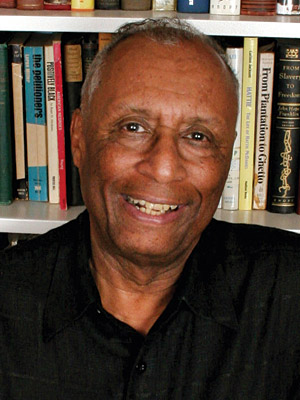Henry T. Sampson
Aerospace Engineer (retired)
BSChE ’56
In recognition of his technical and professional achievements throughout his career with the United States Navy, as well as his contributions as a renowned author and film historian.
Henry T. Sampson remembers a career day at Morehouse College that changed his life and, “Contrary to what you read on the Internet, I had nothing to do with the cell phone,” but was a pioneer in the technology now used in cell phones.
Sampson’s journey from Jackson, Miss., to West Lafayette occurred thanks to the intervention of an unknown Purdue grad. “I was attending Morehouse in Atlanta. I went to Senior Career Day even though I was a sophomore. I spoke to a Pfizer rep, a Purdue grad who bragged about Purdue. I worked in Chicago that summer and took a bus to West Lafayette to check out Purdue. It was love at first sight.”
Purdue prepared Sampson “excellently. Everything I know about chemical engineering I learned at Purdue.”
Sampson was a pioneer in academia as one of the first African-American chemical engineering graduates. He went on to become the first African-American to earn a PhD in nuclear engineering in the U.S.
From 1956-61, Sampson worked as a research chemical engineer at the U.S. Naval Weapons Center, China Lake, Calif., in high-energy solid propellants and case-bonding materials for solid-rocket motors. “The U.S. Naval Ordinance Test Station was a godsend. When I graduated from Purdue, I found many companies wouldn’t hire an African-American engineer,” he says.
Sampson holds his master’s degree in engineering from UCLA. Following graduate studies, Sampson joined the Aerospace Corp. in El Segundo, Calif., as project engineer (1967-81), then director of planning and operations, Directorate of Space Test Program (1981-87). He led senior engineering staff in every phase from planning to launching and space operation of several satellites. He was a vanguard engineer examining how to power satellites.
On July 6, 1971, Sampson was awarded a patent with George H. Miley for the invention of the gamma-electric cell, a direct-conversion energy device that converts the energy generated from the radiation of high-energy gamma rays into electricity.
Other patents include a binder system for rocket propellants and explosives and a case-bonding system for cast-composite rocket propellants, both related to the manufacturing and production of solid-propellant rocket motors.
Sampson is a frequently cited authority on the contributions of African-Americans in cinema and performing arts in the U.S. His seven books include a two-volume set, “Blacks in Black Face: A Source Book on Early Black Musical Shows” (to be released next month), and several reference books examining the frequently overlooked contributions of African-Americans in American stage and cinema from the end of the Civil War to the beginning of the radio and TV age.
As for the Distinguished Engineering Alumnus award, Sampson says it’s “very special because I consider Purdue the starting point of my engineering profession. It was there I took an elective course in nuclear engineering that inspired me to pursue my graduate degrees in nuclear engineering.”
Sampson is married to Dr. Laura Young-Sampson, associate professor, California State University-San Bernardino.
Career Highlights
| 2012 | Entrepreneur of the Year Award, Friends of Engineering, Computer Science and Technology, California State University-Los Angeles |
|---|---|
| 2009 | Outstanding Chemical Engineer, Purdue University |
| 1983 |
Applied Science and Education Award, Blacks in Engineering, Los Angeles Council of Black Professional Engineers |
| 1982 | Black Image Award, Aerospace Corporation |
| 1967 | PhD NE, University of Illinois |
| 1965 | MSNE, University of Illinois |
| 1964-67 | Atomic Energy Commission Honor |
| 1962-64 | Fellow, U.S. Navy |
| 1961 | MSE, UCLA |
| 1956 | BSChE, School of Chemical Engineering, Purdue University |
| 1952-54 | Morehouse College |

